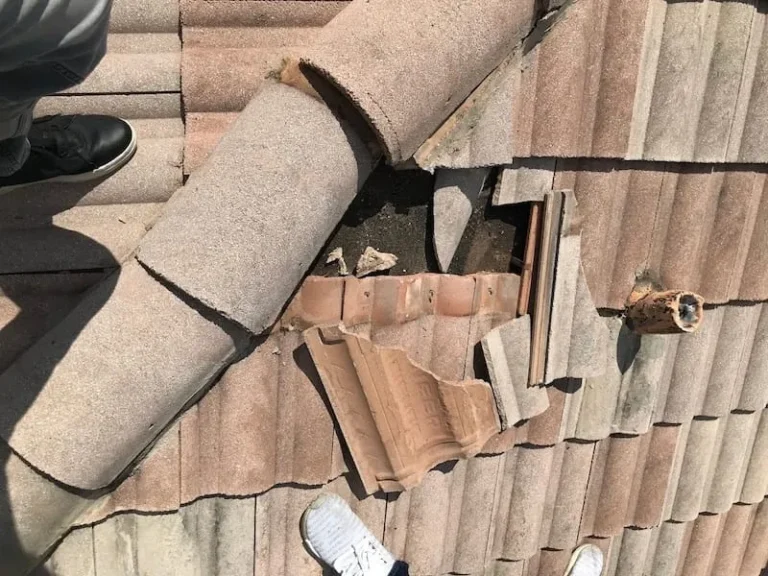A roof leak can be stressful. In this guide, we’ll walk you through how to find and repair a roof leak in Florida—step by step. After reading this page, you’ll know how to address an active roof leak, identify its cause, and understand your options for fixing it yourself or with a contractor. We’ll even provide specific pointers based on the unique dynamics of Florida roofs.
If you’re reading this blog, chances are you have water dripping from your ceiling and need to know how to respond. You’ve probably already taken the first step by placing a bucket under the drip, so let’s review the next steps you can take to mitigate the damage.
To get started, follow these steps to locate and fix a roof leak before the damage worsens.
It goes without saying, but you’ve probably already done this—placing a bucket under the leak is the first step. Sometimes, it’s possible to place a bucket in the attic to catch the leak directly under the source. However, be mindful of the risks involved in walking around in an attic.
If the leak seems to be spreading or gathering in one area, it can be helpful to use a small nail or screwdriver to poke a small hole in the ceiling. This will allow the water to go directly into the bucket. It also helps to prevent the roof leak from damaging more of your drywall.
If you’re able to look inside the attic while there is still an active drip coming in, it will be easier to identify the location of the leak. This will also help you to know what to look for once you are outside or on the roof.
Be sure to take pictures of the roof leak from inside the home, in the attic, and outside. All of these photos will help in case you need to call a roofer or your insurance company.
Because of how dangerous it can be to get on a roof, we don’t recommend that you do this. After inspecting the roof leak from the attic, you might be able to see the culprit from the ground. But in the event that this is not possible, a thorough inspection of the roof will need to be performed. Since there are many things to look for when checking your roof for a leak, keep reading and we’ll discuss how to find a roof leak on all of the common types of roofs we have in Florida, and when to schedule a roof inspection if you’re unsure.
If you have an active roof leak and would like to hire a roofer to fix it, contact us today!
When it comes to roof leak repair in Florida, each roofing system has unique problem areas, for example, around the flashing, pipes, vents, or exposed fasteners. There are also more specific causes that are known to each type of roof. This will help you find and fix the roof leak faster once you know specifically what to look for.
Shingle roofs are known to leak as a result of exposed nails and sealant failure. As shingles get older, the sealant that holds them together will fail. Some manufacturers only warranty the sealant for 12 to 15 years. So with high winds, which are common in Florida, the shingle can easily blow off.
Nails can also be the common cause of the roof leak. If the nail was placed in an area that is exposed, it’s an easy leak. But a nail could also be causing an issue even if it’s not exposed, simply being too close to a seam where two shingles come together or too close to the center of a valley. You won’t be able to see these nails till you lift the shingle tab.
If you have a corrugated roof, the most common reasons it will leak are the exposed fasteners or the seams where two pieces of metal come together. The exposed fasteners on this type of roof are meant to be exposed. But the seal can age, or the fastener can be installed at an angle, allowing water in.
It’s also possible that on any metal roof, there is a picture in the metal. While if you have a standing seam metal roof, which is very common in Florida, rust, corrosion, and panels slipping out of place are common causes of leaks.
Bonding water and broken seams tend to be the most common issues on flat roofs. If the drainage of the roof is hindered and water ponds on your roof for more than 48 hours, it can cause the roof to age quicker and damage the seams. But in general, the seams through the roof tend to be the first thing that leaks. This could be from poor workmanship but also from simply the age of the roof.
Broken or missing tiles, while easy to spot from the ground, don’t always equate to being the cause of the roof leak. The underlayment under the tile is what waterproofs the home. This underlayment will have seams that overlap throughout the roof and along all the edges, walls, and penetrations on the roof. Each of these seams can cause a leak if they become separated from each other or the flashing. Poor installation and the age of the roof are typically the main reasons for this issue to occur.

There are so many different types of leaks and materials that it would be impossible to cover all of those in one article. But here is a general understanding of what your options are when it comes to repairing a roof leak.
You can begin addressing a roof leak by placing a tarp over the damaged area. Other temporary fixes might include applying caulk or roofing tar (also called roof cement or ‘bull’) to the affected spot. However, these are only short-term solutions and shouldn’t be left in place for more than a week or two. Be cautious with roof tar, as it can sometimes cause more damage by trapping water and leading to backups in other areas of the roof.
There is no one-size-fits-all approach to repairing a roof leak. But in most of the types of roof damage mentioned above, the proper way to fix them will be to replace the material directly around the damage. For major damage, you may need a full roof replacement to ensure long-term protection.
This could mean that a vent and the shingles around it need to be replaced, or an entire 10-foot section of the valley needs to be replaced. Chances are, you will need to remove the old roofing material down to the plywood, in some cases even replacing the plywood. This is followed by installing brand new material.
Roof leaks don’t just create stains—they open the door to mold, wood rot, and costly structural damage. Florida’s intense rain and heat make timely roof leak repair even more critical. Acting early protects your home and saves you money in the long run.
The best way is to hire a company that will replace all of the compromised roofing material around the leak and install new material. Simple patches and temporary fixes rarely last. And if possible, secure a warranty on the repair.
A repair that lasts and is not a temporary repair is going to cost anywhere from $500 to $2,000+. This, of course, is a ballpark number that is dependent on many components. The size of the damage, the quality of your roofing material, and more. So it’s impossible to give an accurate number without inspecting the leak first.
Every insurance policy is different, and in some cases there is a good chance that could be covered. So we recommend checking with your insurance provider to know for sure what your options are. Be sure to take photos and document everything related to the leak if you do this. If you call a roofer out, make sure they provide photos and documentation to you of what they find.
Yes, quite often you don’t have to replace the whole roof. You can simply repair the section of roof that is damaged. There are scenarios where the damage is widespread throughout the roof, often from poor workmanship or aging. But in these cases, your roofer should be able to present photos explaining this issue.
With over 30 years of experience and an A+ BBB rating, Renegade Roofing has earned the trust of thousands of homeowners across South Florida. As both licensed roofing contractors and general contractors, we deliver expert roof leak repair for every roofing system—from shingles to tile, metal, and flat roofs.
If you need a roofer in Deerfield Beach, Boca Raton, or West Palm, contact us today! See our work in action by visiting our gallery, and find out why Renegade Roofing is recognized as one of Florida’s top roofing contractors by exploring our company page.

Contact us.
HOURS OF OPERATION
SERVICE LOCATIONS